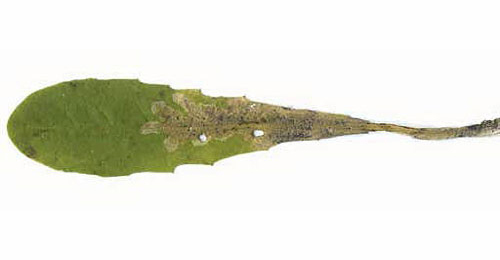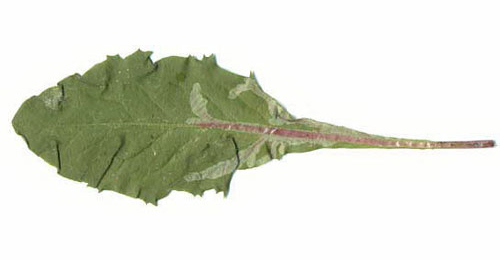|
||||||
|
CICERBITA. Blue Sow-thistles. [Asteraceae] |
|
Four species of Cicerbita, are recorded in Britain. These include the native Alpine Sow-thistle (C. alpina) and the introduced Pontic Blue-sow-thistle (C. bourgaei), Common Blue-sow-thistle (C. macrophylla) and Hairless Blue-sow-thistle (C. plumieri). Alpine Sow-thistle (C. alpina) is protected under Schedule 8 of the Wildlife and Countryside Act, 1981. Six or seven British miners are recorded on Cicerbita. A key to the European miners recorded on Lactuca including Cicerbita is provided in Bladmineerders van Europa. |
Key for the identification of the known mines of British |
|||||||||
1a > Leaf-miner: Mine primarily associated with the mid-rib. |
|||||||||
1b > Leaf-miner: Mine not primarily associated with the mid-rib. |
|||||||||
2a > Leaf-miner: A distinctive mine primarily above mid-rib, with irregular short lateral offshoots into leaf blade. Pupation external (Spencer, 1972: 51 (fig. 172), 55; Spencer, 1976: 270, 271 (fig. 486)). Branched, whitish, upper-surface corridor; main axis overlying the midrib; side branches overlying the main lateral veins. (In Campanula and Phyteuma the mine is much less branched, sometimes nothing more than a corridor on top of the midrib). Frass in rather long strings. Usually the mines begins as a long and narrow, shallow, tortuous lower-surface corridor that ends upon the midrib but otherwise is not associated with the leaf venation. Often this initial corridor is filled with callus, and then even less conspicuous. Pupation outside the mine. A linear mine on the upper surface, usually following the midrib and showing side branches along the veins. The frass is in strings. |
|||||||||
|
|||||||||
|
|||||||||
Liriomyza strigata (Meigen, 1830) [Diptera: Agromyzidae]. |
|||||||||
2b > Leaf-miner: A whitish blotch-mine along mid-rib, with offshoots into leaf blade. Pupation takes place at the base of the mid-rib. Puparium yellowish white |
|||||||||
 Mine of Ophiomyia cunctata on Taraxacum officinale Image: © Willem Ellis (Bladmineerders van Europa) |
|||||||||
|
|||||||||
Ophiomyia cunctata (Hendel, 1920) [Diptera: Agromyzidae]. |
|||||||||
2c > Leaf-miner: A whitish blotch-mine along the mid-rib, with lateral offshoots into the leaf blade. Pupation at base of leaf in petiole (Spencer, 1972b: 25). Broad corridor overlying the midrib, with short excursion into the blade, mainly in its basal part. Frass concentrated in the basal part of the mine, corridors almost free from frass. Pupation in the mine, also in the basal part. |
|||||||||
 Mine of Ophiomyia pulicaria on Taraxacum officinale Image: © Willem Ellis (Bladmineerders van Europa) |
|||||||||
|
|||||||||
Ophiomyia pulicaria (Meigen, 1830) [Diptera: Agromyzidae]. |
|||||||||
2d > Leaf-miner: A white mine along mid-rib, with offshoots into leaf blade. Pupation internal at base of mid-rib. In Asteraceae the larva mostly lives as a borer in the midrib of the leaves. From there short corridors are made into the blade. Also a corridor can be made overlying the midrib. In Euphorbia a small mine is made in the bracts of the inflorescence. The final mine strongly resembles the one of Liriomyza strigata, but the branches are vritually free from frass; this is acccumulated in the resting place of the larva, in the base of the midrib. There also pupation takes place. Forms a mine along the midrib and has feeding spurs into the leaf. Pupation is in the mine at the base of the midrib. |
|||||||||
| Last updated 02-Jul-2019 Brian Pitkin | ||

